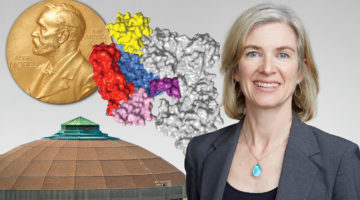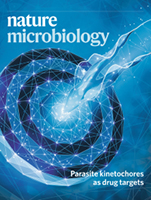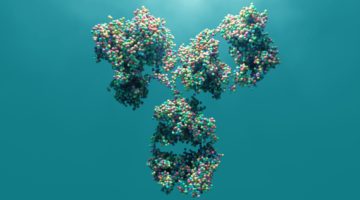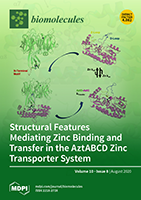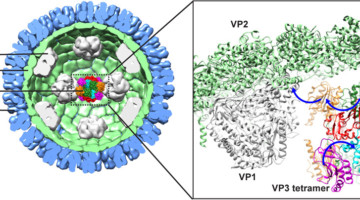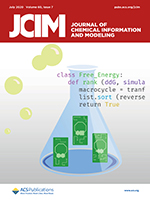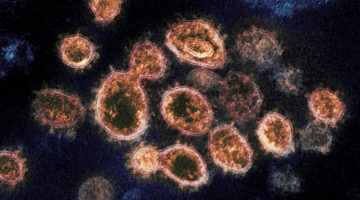The 2020 Nobel Prize in Chemistry was awarded to Jennifer Doudna and Emmanuelle Charpentier for the development of a world-changing gene-editing technology. At the ALS, Doudna’s work on CRISPR-Cas9 was enabled by many visionary people with innovative ideas, implemented in support of a world-class structural biology program. Read more »![]()
ALS Work Using Protein Crystallography
Protein crystallography is used for determining the molecular structure of proteins. Crystallized protein molecules cause a beam of incident x-rays to scatter in many directions, with constructive and destructive interference generating a diffraction pattern. By analyzing these patterns, a crystallographer can produce a three-dimensional picture of the density of electrons within the crystal and thus determine the protein's structure.
Study Finds ‘Missing Link’ in the Evolutionary History of Carbon-Fixing Protein Rubisco
Scientists discovered an ancient form of rubisco, the most abundant enzyme on Earth and critical to life as we know it. Found in previously unknown environmental microbes, the newly identified rubisco provides insight into the evolution of the photosynthetic organisms that underlie the planet’s food chains. Read more »
Targeting the trypanosome kinetochore with CLK1 protein kinase inhibitors
Saldivia et al. identify CLK1 as the target for the amidobenzimidazoles series of compounds. Inhibition of this protein kinase impairs inner kinetochore recruitment, causing cell-cycle arrest and cell death in trypanosomal pathogens such as Trypanosoma brucei. Read more »
Providing New Technologies for Vaccine Development
Antigens can sometimes be attached to a protein scaffold to mimic the shape of a virus and elicit a stronger immune response. Scientists developed a method to design such proteins, and ALS data helped to visualize the atomic structure and determine the dynamics of the designed scaffolds. Read more »
Missing Lysine Link Could Improve Plant-Based Nutrition
To engineer crops with higher levels of the important amino acid, lysine, researchers solved the structure of an enzyme that helps break down lysine in plants. A fuller understanding of the factors affecting lysine levels should aid in the successful development of stable high-lysine crops to combat malnutrition globally. Read more »
How Proteins Remodel DNA in Bacteria under Stress
Multiscale, multimodal visualization techniques at the ALS enabled researchers to clarify how proteins remodel bacterial DNA in response to stressful environments. The discovery could lead to new strategies for controlling microbial behavior and, eventually, new ways to fight bacterial infections. Read more »![]()
![]()
Structural Features Mediating Zinc Binding and Transfer in the AztABCD Zinc Transporter System
Zinc homeostasis is critical for bacterial survival and virulence. Extracellular zinc-binding proteins play an important role in this process. This work assesses the role of several flexible or unstructured sequences in zinc binding and transfer from proteins AztD to AztC. The results provide insights into the dynamic nature of these processes and support a previously proposed structural model of transfer. Read more »
Rotavirus VP3 Is a Multifunctional Capping Machine
Rotavirus, a major cause of infantile gastroenteritis, is responsible for the deaths of about 200,000 children per year. Although vaccines are available, the virus still circulates, and a fuller understanding of the viral structures is needed. Here, scientists investigate the structure and function of the last unsolved rotavirus structural protein. Read more »
Evaluation of Free Energy Calculations for the Prioritization of Macrocycle Synthesis
Free energy perturbation methods represent a paradigm shift in drug discovery, where computational methods inform benchtop activities. Macrocycles are highly constrained molecules, often resulting in nonintuitive structure–activity relationships requiring lengthy synthetic routes. Free energy perturbation methods can be used to predict potency, guiding synthetic chemistry efforts to de-risk complex synthesis. Read more »
Antibody from SARS Survivor Neutralizes SARS-CoV-2
Using structural data from the ALS and cryo-electron microscopy, researchers have characterized how an antibody binds to and neutralizes SARS-CoV-2. This work provides the basis for therapeutic and vaccine development for the SARS-CoV-2 virus, which is responsible for the COVID-19 pandemic. Read more »![]()
![]()
- « Previous Page
- 1
- …
- 4
- 5
- 6
- 7
- 8
- …
- 15
- Next Page »
